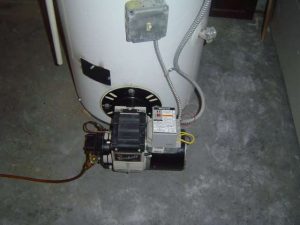To Reduce Mineral Deposit Build up Drain and Flush Water Heaters Annually
By Mark J. Donovan
|
|
Draining and flushing water heaters should be part of every home maintenance schedule. Even municipal water supplies contain minerals and sediments and left unchecked can shorten the life of your water heater. Consequently it is wise to drain and flush a water heater at least once a year to remove the mineral and sediment buildup.
Drain and Flush Water Heater Instructions To drain and flush a water heater, first make sure that the electricity or gas to it has been turned off and allow time for the water to cool in the tank. After allowing time for the water to cool a bit, turn off the cold water inlet supply valve to the water heater and attach a garden hose to the drain valve. |
Run the garden hose outside, or to a floor drain, so that the water can exit the water heater without spilling in the home.
Next, turn on a hot water faucet somewhere in the house, e.g. sink or tub. This will allow air to enter the hot water pipes and enable the water to drain from the water heater tank more easily.
Once the water drains clear from the water heater, turn both the cold water inlet supply line valve and drain valve off and remove the garden hose. Also turn off the hot water faucet that you had earlier turned on inside the home.
Next, turn the cold water inlet supply line valve back on and allow the water heater tank to fill.
| Once the water heater has filled, place a bucket underneath the pressure water heater relief valve and flip the lever up to discharge a little water from it. Then close the lever down and confirm that no more water drips from it. The pressure water heater relief valve, as the name suggests, prevents the pressure from building up too high in the water heater. In the event that the pressure or temperature within the water heater does exceed the rating capacities of the pressure relief valve, it will automatically open up and reduce the water pressure.
When this occurs, unfortunately, water will spill on the floor if it is not designed to feed into a floor drain. |
 |
Upon confirming that the water heater pressure relief valve is working properly you can turn the electric or gas back onto the water heater. And with the power turned back on, you’ve completed the process of draining and flushing a water heater.
Again, it is important to drain and flush water heaters annually in order to improve the operating efficiency of it, extend the life of the water heater, and provide clean hot water to the home. So don’t forget to include a line item in your home maintenance schedule to drain and flush water heater annually.
For information on Restoring Baseboard Heating Element Covers, see the Restoring Baseboard Heating Element Covers eBook from HomeAdditionPlus.com. The Restoring Baseboard Heating Element Covers Ebook provides easy to understand, step-by-step instructions, on how to restore Baseboard Heating Element Covers so that they look new again. Pictures are included for every key step in the process.
For information on how to maximize a wood stove’s heating efficiency, see HomeAdditionPlus.com’s Installation of Hood over Wood Stove eBook.
Related Information
- How to Choose a Gas Water Heater
- Buderus Boiler and Riello Burner Installation Review
- How to Keep Your Home Warm and Cool with a Geothermal System
Additional Heating and Cooling Resources from Amazon.com
 |
 |
Free Heating and Cooling Price Quotes with No Obligation!
Fill out our 3-5 minute quick and easy form, and receive a free price quote on heating & cooling from one of our pre-screened and licensed HVAC contractors. This process is free and there is no obligation to continue once you receive your heating & cooling price estimate.

